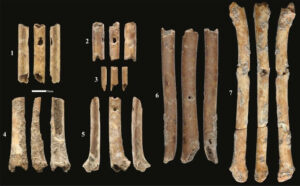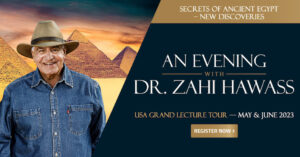
CNRS—Although the prehistoric site of Eynan-Mallaha in northern Israel has been thoroughly examined since 1955, it still holds some surprises for scientists. Seven prehistoric wind instruments known as flutes, recently identified by a Franco-Israeli team1 , are the subject of an article published on 9 June in Nature Scientific Reports. The discovery of these 12,000-year-old aerophones is extremely rare – in fact, they are the first to be discovered in the Near East. The “flutes”, made from the bones of a small waterfowl, produce a sound similar to certain birds of prey (Eurasian sparrowhawk and common kestrel) when air is blown into them. The choice of bones used to make these instruments was no accident – larger birds, with bigger bones that produce deeper sounds, have also been found at the site. The Natufians, the Near Eastern civilization that occupied this village between 13,000 and 9,700 BC, deliberately selected smaller bones in order to obtain the high-pitched sound needed to imitate these particular raptors. The instruments may have been used for hunting, music or to communicate with the birds themselves. Indeed, it is clear that the Natufians attributed birds with a special symbolic value, as attested by the many ornaments made of talons found at Eynan-Mallaha. The village, located on the shores of Lake Hula, was home to this civilization throughout its 3,000 years of existence. It is therefore of vital importance in revealing the practices and habits of a culture at the crossroads between mobile and sedentary lifestyles, and the transition from a predatory economy to agriculture. This work2 was supported by the Fyssen Fondation and the ministère des Affaires étrangères.
_______________________________

The seven aerophones discovered at Eynan-Mallaha. © Laurent Davin
_______________________________
Article Source: CNRS news release
_______________________________
Notes
- 1- The team is co-directed by Laurent Davin (post-doctoral researcher at the Fyssen Fondation) and José-Miguel Tejero (University of Vienna, University of Barcelona) and includes scientists from the Centre de recherche français à Jérusalem (CNRS/Aix-Marseille Université/ministère de la Culture), the laboratoire Technologie et ethnologie des mondes préhistoriques (CNRS/Université Panthéon-Sorbonne/Université Paris Nanterre), The Hebrew University of Jerusalem (Institute of Archaeology), Israel Antiquities Authority, Virginia Commonwealth University (Department of Forensic Science), École Nationale Vétérinaire (Laboratoire d’Anatomie comparée, Nantes), the laboratoire Archéologies et sciences de l’Antiquité (CNRS/ministère de la Culture/Université Panthéon-Sorbonne/Université Paris Nanterre) and the l’Institut d’ethnologie méditerranéenne, européenne et comparative (CNRS/Université Aix-Marseille).
- 2- Excavation of the Eynan-Mallaha site is still ongoing, under the direction of CNRS researcher Fanny Bocquentin and Israel Antiquities Authority researcher Lior Weisbrod.
Bibliography
Bone aerophones from Eynan-Mallaha (Israel) indicate imitation of raptor calls by the last hunter- gatherers in the Levant. Laurent Davin, José-Miguel Tejero, Tal Simmons, Dana Shaham, Aurélia Borvon, Olivier Tourny, Anne Bridault, Rivka Rabinovich, Marion Sindel, Hamudi Khalaily and François Valla. Nature Scientific Reports, June 8 2023. https://doi.org/10.1038/s41598-023-35700-9 (This link will work when the embargo is lifted)
______________________________
Advertisement
______________________________

Don’t miss out on this unforgettable evening as Dr. Hawass reveals the most closely guarded secrets of ancient Egypt and presents his groundbreaking new discoveries and latest research live on stage. As the man behind all major discoveries in Egypt over the last few decades and director of several ongoing archaeological projects, Dr. Hawass may yet surprise you with unexpected revelations that will make news across the world.
______________________________





